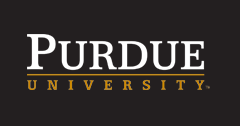Research Website
https://sites.google.com/site/thehalllabpurdue/people
Keywords
Cell division cycle 14 (Cdc14), Mitosis, Cyclin-dependent kinase (Cdk)
Presentation Type
Poster
Research Abstract
Cyclin-dependent kinases (Cdk) drive cell cycle progression and reversal of Cdk phosphorylation is essential for mitotic exit. Cdc14 is a widely conserved family of protein phosphatases that reverse Cdk phosphorylation. Recently, Cdc14 was also found to be essential for pathogenicity of some fungal plant pathogens. Fungal pathogens, like Ustilago maydis, decrease agricultural crop yield costing global agriculture by some accounts $60 billion per year. Since Cdc14 is absent in plants, a fungi specific Cdc14 inhibitor could be made to reduce the pathogenicity of U. maydis and other fungal plant pathogens to increase crop yields. To guide inhibitor development, a three-dimensional structural model of fungal Cdc14 is needed. Therefore, we recombinantly expressed Ustilago maydis Cdc14 (UmCdc14) and a catalytically inactive substrate trapping mutant (UmCdc14C318S) with N-terminal hexa-histidine tags in E. coli. Recombinant UmCdc14 and UmCdc14C318S were successfully purified using immobilized metal affinity chromatography. We screened the purified proteins by sitting drop crystallography. Two conditions yielded small crystals for UmCdc14. One condition yielded a crystal for UmCdc14C318S. These conditions were used for large scale crystal growth by hanging drop crystallography. If ideal conditions are found, UmCdc14C318S will be crystallized bound to a peptide substrate to capture the molecular binding determinants that will help guide inhibitor design. Wild-type UmCdc14 will be crystallized bound to small molecule inhibitors identified by a previous high throughput library screen. In the future, we will also explore crystallization of Cdc14 orthologs from other plant pathogens.
Session Track
Structures and Nanomaterials
Recommended Citation
John Whitney, Kyle Wettschurack, Mark Hall, Jeremy Lohman, Aaron Benjamin, and Lee M. Stunkard,
"Biochemical and structural characterization of Cdc14 phosphatases from pathogenic fungi"
(August 4, 2016).
The Summer Undergraduate Research Fellowship (SURF) Symposium.
Paper 127.
https://docs.lib.purdue.edu/surf/2016/presentations/127
Included in
Biochemical and structural characterization of Cdc14 phosphatases from pathogenic fungi
Cyclin-dependent kinases (Cdk) drive cell cycle progression and reversal of Cdk phosphorylation is essential for mitotic exit. Cdc14 is a widely conserved family of protein phosphatases that reverse Cdk phosphorylation. Recently, Cdc14 was also found to be essential for pathogenicity of some fungal plant pathogens. Fungal pathogens, like Ustilago maydis, decrease agricultural crop yield costing global agriculture by some accounts $60 billion per year. Since Cdc14 is absent in plants, a fungi specific Cdc14 inhibitor could be made to reduce the pathogenicity of U. maydis and other fungal plant pathogens to increase crop yields. To guide inhibitor development, a three-dimensional structural model of fungal Cdc14 is needed. Therefore, we recombinantly expressed Ustilago maydis Cdc14 (UmCdc14) and a catalytically inactive substrate trapping mutant (UmCdc14C318S) with N-terminal hexa-histidine tags in E. coli. Recombinant UmCdc14 and UmCdc14C318S were successfully purified using immobilized metal affinity chromatography. We screened the purified proteins by sitting drop crystallography. Two conditions yielded small crystals for UmCdc14. One condition yielded a crystal for UmCdc14C318S. These conditions were used for large scale crystal growth by hanging drop crystallography. If ideal conditions are found, UmCdc14C318S will be crystallized bound to a peptide substrate to capture the molecular binding determinants that will help guide inhibitor design. Wild-type UmCdc14 will be crystallized bound to small molecule inhibitors identified by a previous high throughput library screen. In the future, we will also explore crystallization of Cdc14 orthologs from other plant pathogens.
https://docs.lib.purdue.edu/surf/2016/presentations/127

